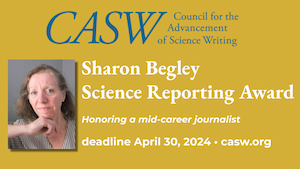By Briley Lewis. Mentored and edited by Alexandra Witze.
What would you do if the power went out? Our lives are increasingly reliant on technology; our work and our social lives often require access to the internet. Lights, televisions, and refrigerators require electricity to run. These devices, and the power grid as a whole, are subject to a major threat society is not totally prepared for: the Sun’s bad behavior.
“Our Sun is naturally a magnetically active star, and it’s really pretty well behaved compared to other stars. But it does have fits, it does become prickly,” said Delores Knipp, an atmospheric scientist at the University of Colorado Boulder. On February 19 at the American Association for the Advancement of Science (AAAS) annual meeting, she and other experts discussed how often space weather — the disturbances originating from the Sun, also known as solar storms — happens, and how it affects life on Earth.
The intensity of the Sun’s activity ebbs and flows over an 11-year pattern, known as the solar cycle. The Sun is approaching the current cycle’s maximum level, with the greatest amount of solar activity expected between 2023 and 2026. When a solar storm reaches Earth, the energetic particles spiral along the planet’s magnetic field lines, cascading toward the poles where they interact with the atmosphere and create a spectacular show in the northern and southern lights. Solar storms can also have other far-reaching effects such as changing the density of the upper atmosphere — which aerospace company SpaceX discovered last month when a small solar storm caused its satellites to encounter more atmospheric drag, falling out of the sky and burning up in Earth’s atmosphere.
Minor solar storms occur about every other week, Knipp said, and society has mostly learned to live with them. Extreme events, though, only happen every few years, and can create intense magnetic and electric fields on the planet’s surface.
Knipp is interested in the most extreme events the Sun has to offer. A famous example is the Carrington Event of 1859, the most powerful solar storm in recorded history. The electric currents created were strong enough that an eyewitness reported “streams of fire” erupting across telegraph wires in Pittsburgh. Extraordinary solar storms like the Carrington Event can create aurorae in low-latitude places that aren’t accustomed to seeing them, such as the southern United States, Egypt, and India.
People have only been measuring the strength of magnetic fields regularly since the mid-19th century, resulting in fewer than 200 years of scientific records of solar storms. And since extreme space weather doesn’t happen often, scientists don’t have a clear picture of how regularly it happens and how bad it can get.
One solution is to look to history, searching for written records and art that capture great aurorae. Many past civilizations considered space weather events to be significant, and some even feared them as bad omens. The earliest known written record of a great aurora comes from 576 B.C., from a clay tablet unearthed in Babylon. This illustrates how humans have been observing the sky for millennia, and also just how shocking the great aurora was. Painstakingly carving an account into clay took substantial work, so the event must have been significant to its recorder.
Knipp recently delved into digital records from researchers across the world to create a timeline of extreme solar storms over the past 500 years. Her research, published last year in the Journal of Space Weather and Space Climate, is the most detailed look yet at the long history of solar storms. She and her colleagues found 14 events over the past half-millennium, showing that these extreme storms happen about every 40 to 60 years or every four to five solar cycles. Each of these events would have been strong enough to disrupt electrical equipment, and the most recent in 1989 caused the temporary collapse of the HydroQuebec power grid in northeastern Canada. Even more storms were visible at higher latitudes, about once per solar cycle in the past 70 years.
“Some of these interactions as they reach Earth can create the great aurorae which terrified our ancestors. We can be a little calmer about it,” Knipp explained at the AAAS meeting. “But even as we’re saying they’re beautiful, we have to be thinking about just how bad it could get for our technology.”
Jennifer Gannon, a scientist from Computational Physics Inc., told the meeting about some of the effects that space weather can have on modern life, particularly on power grids. Space weather can create effects on the ground known as geomagnetically induced currents. These electrical fluctuations can cause blackouts such as the 1989 Canadian outage. Today, scientists and engineers are working to understand where the greatest risk is and how to mitigate it, such as improving space weather forecasting and developing technologies to quickly repair power infrastructure in case of an outage.
Astronomers are also working to understand what causes space weather in the first place. NASA’s Parker Solar Probe spacecraft aims to provide insight into this question by dipping closer to the Sun than any probe has gone before, taking images of the Sun and measuring magnetic fields, temperatures, and information about the electrons and other particles speeding towards Earth. Parker, which launched in 2018, happened to be near a solar outburst in early February of this year, which will provide its first direct look into one of these particle ejections. “We have been waiting for something like this since launch,” said Nour Raouafi, a solar physicist at the Johns Hopkins University Applied Physics Laboratory and the probe’s project scientist. The mission team is now eagerly awaiting the data, which should be downloaded from the spacecraft in the coming weeks and could reveal how these large outbursts are created by the Sun.
Space weather has always been a part of human life. Now, though, scientists are finally on the path to understanding its origins and effects.
Briley Lewis is a Ph.D. candidate and NSF fellow at the University of California Los Angeles studying astronomy and astrophysics. She is a member of the Astrobites collaboration and a freelance science writer with articles in Scientific American, Massive Science, The Xylom, and more. She teaches writing at UCLA in her course for first-year undergraduates, “Astrobiology in Science Journalism.” Follow her on Twitter @briles_34 or visit www.briley-lewis.com
Hero photo: An exceptional auroral event in Germany in the 1500s, as depicted by an artist. Credit: Courtesy Delores Knipp

.png)

